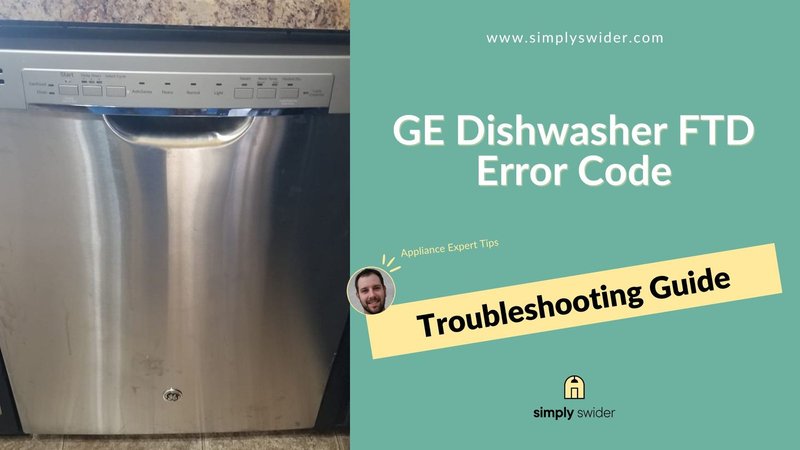
First, let’s break down what an error code like “F1” signifies. An error code is a bit like your dishwasher’s way of sending you a message. It’s saying, “Hey, there’s something not right here!” In the case of the F1 error code on GE dishwashers, it’s often related to a water leak or a problem with the flood switch. While it might seem tempting to close the dishwasher door and walk away, a water leak can lead to more severe issues, and ignoring it might just be asking for trouble in the long run.
Understanding the F1 Error Code
So, what exactly does that F1 error code mean when it pops up on your dishwasher display? At its core, the F1 code indicates that your dishwasher has detected an internal water leak. Picture it like this: your dishwasher is a bit like a closed ecosystem, designed to handle a certain amount of water coming in and draining out. When the balance tips, the sensors alert you with an error code.
When the F1 error appears, it typically means water has leaked into the base pan of your dishwasher. This could be due to a variety of reasons, from a faulty seal to a loose hose, or even a build-up of detergent that’s causing the overflow. It’s like when you fill a glass with too much water and it spills over—only in this case, the spill happens inside the machine where you can’t see it.
If you ignore this issue, it could spell disaster down the road. Water that leaks internally can damage electrical components, lead to mold growth (yuck!), or even cause your dishwasher to stop working entirely. So while you might be tempted to shrug it off as a one-time fluke, it’s essential to investigate the cause of the leak to keep your dishwasher—and your kitchen floor—dry and safe.
Common Causes of the F1 Error
Now, you might be wondering, “Why would my dishwasher suddenly have a leak?” Well, there are a few usual suspects that could be the culprit behind the F1 error. One common cause is a clogged or misaligned door seal. Just like how a poorly fitted window lets in a draft, a door seal that’s not perfectly aligned can let water escape.
Another possible cause is a problem with the dishwasher’s water inlet valve. Think of this valve like a spout that controls how much water gets into your dishwasher. If it’s letting in too much water, it can be like turning the faucet on full blast, leading to an overflow inside the machine. Additionally, a malfunctioning float switch—which acts like a water level sensor—could also be miscommunicating with the dishwasher, causing it to fill up more than necessary.
Finally, don’t forget about the plumbing connections. Loose hoses or fittings can also lead to pesky leaks. If any of these parts aren’t playing nicely, they’ll trip the F1 error code as an SOS to prevent further water damage.
Addressing the F1 Code: What to Do Next
Alright, so you’ve got this F1 error code staring back at you. What’s the next step? Well, here’s the deal: it’s time to roll up your sleeves and do a little detective work. Start by turning off the power to the dishwasher—safety first!—and then check for any visible signs of water around the base or near connections. A flashlight can be your best friend here.
If you spot any puddles or moisture, drying them out is a good starting point. Once things are dry, inspect the door seal, the water inlet valve, and make sure all hoses are secure and intact. It might feel like you’re playing a game of Clue, but each check helps narrow down the potential cause.
If you’re not comfortable diving into dishwasher repair, or if the problem persists, calling in a professional might be the best course of action. They have the tools and expertise to diagnose and fix the issue properly—potentially saving you from bigger headaches (and costs) in the future.
Preventing Future Errors and Leaks
Now that you’ve tackled the error, how do you prevent it from happening again? Prevention is like putting on sunscreen before heading to the beach—it saves you from a lot of pain later on. Regularly cleaning your dishwasher’s filter and ensuring the door seal is free from debris can help maintain a tight seal. Also, avoid overloading the dishwasher or using too much detergent, as this can stress the machine and cause overflow.
Periodically, check the hoses and connections for any signs of wear or loosening. Think of it like routine car maintenance—catching small issues before they snowball into major repairs. And if you live in an area with hard water, using a water softener can prevent mineral buildup, another potential source of leaks.
In summary, while it might be tempting to ignore the F1 error code on your GE dishwasher, doing so could lead to more significant problems down the line. By understanding the code, addressing the underlying causes, and taking preventive measures, you can keep your dishwasher running smoothly and your kitchen free from unexpected waterworks.